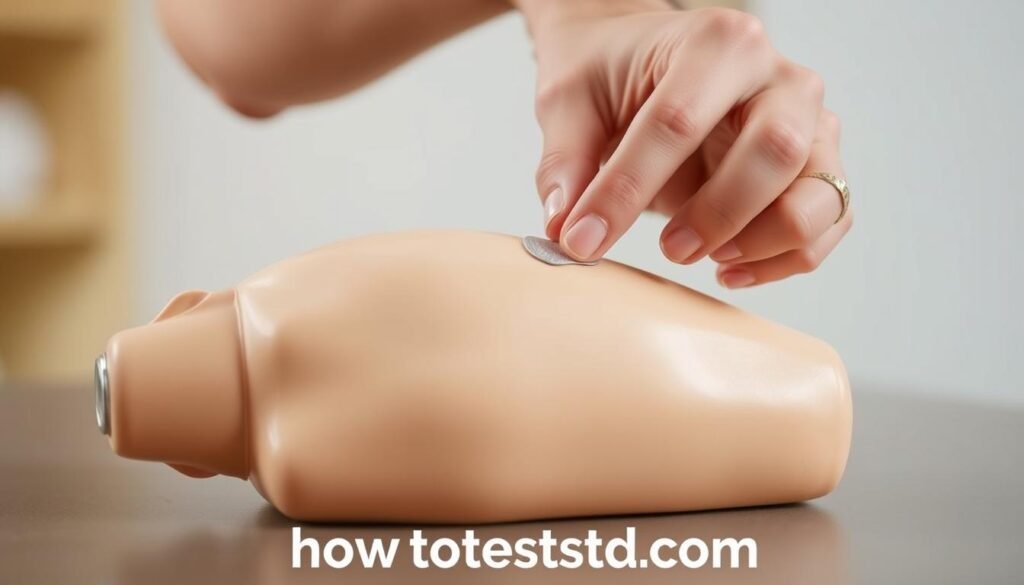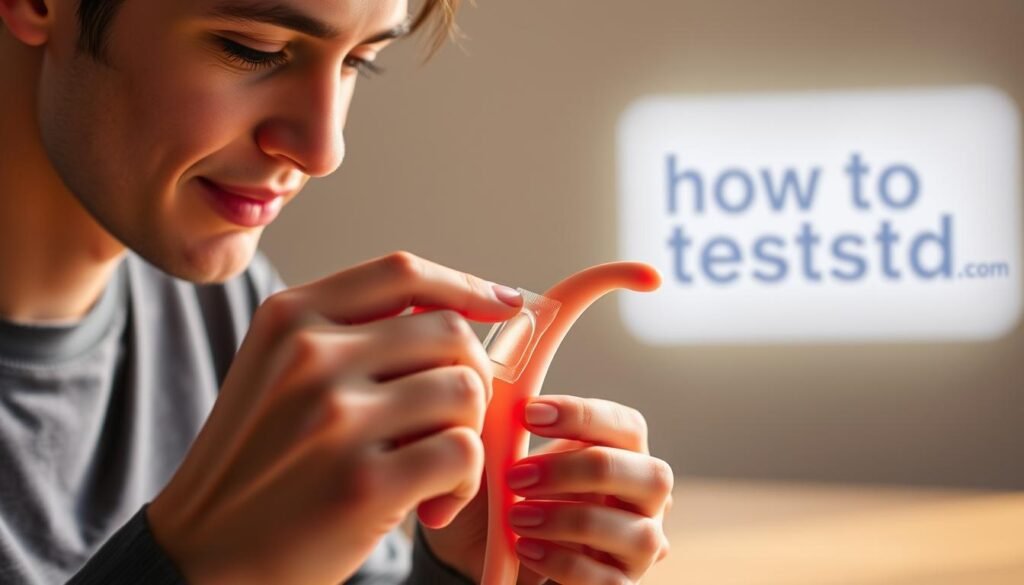Mastering Condom Use: A Simple, Straightforward Tutorial
Nearly 1 in 2 sexually active people will get an STI by age 25 without protection. Using condoms right is key to stop STIs and unwanted babies.
It’s important to be careful about your health. Using protection during sex lowers the risk of getting sick. Knowing how to use condoms safely is a must.
Learning to use condoms well is easy and can really help your health. Don’t wait to get tested – take charge of your health now.
Key Takeaways
- Using condoms correctly prevents STIs and unwanted pregnancies.
- Proper condom use is key for safe sex.
- Being proactive about your health is vital.
- Don’t delay getting tested for STIs.
- Mastering condom use is simple and protects your health.
The Importance of Proper Condom Use
Learning how to use condoms right is key to good sexual health. It’s simple but very important. It helps keep you and your partner safe during sex.
Protection Against STIs and Unwanted Pregnancy
Condoms work well to stop STIs and unwanted babies. Planned Parenthood says they are good for both.
Statistical Effectiveness When Used Correctly
Condoms are 98% effective if used perfectly. But, they are only about 85% effective in real life. This is because of mistakes or breakage.
Health Consequences of Improper Use
Using condoms wrong can increase STI and pregnancy risks. It’s important to do it right to stay safe.
| Condom Use Scenario | Effectiveness | Risks |
|---|---|---|
| Perfect Use | 98% | Low |
| Typical Use | 85% | Moderate |
| Incorrect Use | <85% | High |
Knowing how to use condoms right can lower risks. It’s important to stay informed about sexual health.
Understanding Different Types of Condoms
Condoms are made from different materials. Each has its own good points and things to watch out for. Picking the right one is key for feeling good and staying safe.
Material Options: Latex, Polyurethane, and Lambskin
Latex, polyurethane, and lambskin are the main types of condoms. Latex condoms are very common. They work well against STIs and pregnancy. But, some people might be allergic to latex.
Latex Allergies and Alternatives
If you’re allergic to latex, polyurethane condoms are a good choice. They’re thinner and might feel different. But, they might break more easily.
Lambskin condoms are made from animal skin. They’re not good for stopping STIs because they have holes that let viruses through.
Durability and Sensation Differences
Condoms feel and last differently based on their material. Latex condoms are strong and feel good. Polyurethane condoms are thinner and might feel better but are not as strong.
- Latex: Durable, effective, but may cause allergic reactions.
- Polyurethane: Thinner, alternative for latex allergy, but may be more prone to breakage.
- Lambskin: Natural, but not effective against STIs.
Knowing these differences is important for using condoms right. It helps make sure you have a safe and fun time. Always follow the best practices for condom application and condom dos and don’ts to get the most out of them.
Before You Begin: Essential Preparation Steps
Safe sex starts before you do it. Getting ready is important. It makes things better and keeps you safe from STIs and pregnancy.
Checking Expiration Dates and Package Integrity
First, check the condom’s expiration date. Also, look at the package for damage. Using an old or broken condom is risky. Make sure the package is not torn or open before you use it.
| Check | Action |
|---|---|
| Expiration Date | Verify it’s not expired |
| Package Integrity | Inspect for tears or damage |
Creating a Comfortable Environment
Make the place comfy and calm. You can do this by dimming lights, playing soft music, or keeping the room cool. A calm space makes things better.
Communicating With Your Partner About Condom Use
Talking openly about condoms is important. Talk about what you like, any allergies, or worries. Talking helps make sex better and safer.
By getting ready, you make sex better and safer. Getting ready is the first step to a good time.
How to Put On a Condom: Step-by-Step Guide
Putting on a condom might seem hard at first. But, with a simple guide, it gets easier. This guide will help you learn how to use condoms right and feel confident.
Opening the Package Safely
The first thing to do is open the package. It’s important to do this carefully. This way, you won’t damage the condom inside.
Avoiding Common Package Opening Mistakes
To open the package right, don’t use your teeth or sharp things. They can tear the condom. Instead, tear the package along the edge or use your fingers to open it carefully.
Tip: Always check the expiration date before opening. This makes sure the condom is good to use.
Determining the Correct Direction
After opening, you need to know the right way to put it on. Look at the condom’s roll to see which way it goes.
Visual Cues for Proper Orientation
Look at the rim or edge of the condom to see which way it rolls. If it’s right, it should roll out easily. If not, flip it over.
Remember: If you put it on inside-out, it won’t work. So, make sure it’s the right way before you go on.
By following these steps, you can put on a condom correctly. This makes for a safe and fun experience. The more you practice, the easier it gets.
Common Mistakes and How to Avoid Them
Many people don’t know they’re making mistakes with condoms. It’s important to know these mistakes to stay safe and responsible.
Using Teeth or Sharp Objects to Open Packages
Using teeth or sharp objects to open condoms is a big mistake. It can cause tears or holes, making the condom useless. Always open condom packages with your hands, tearing along the edge carefully.
Putting Condoms on Inside-Out
Putting a condom on inside-out is another mistake. It doesn’t protect you and wastes the condom. Always check the condom’s orientation before applying it. The rim should be outside, and the tip should face away from you.
Not Leaving Space at the Tip
Not leaving enough space at the tip can cause problems. The reservoir tip is designed to collect semen. If there’s not enough space, the condom might burst.
Understanding the Reservoir Tip Function
The reservoir tip helps prevent condom breakage. It’s important to make sure this area is not twisted or damaged during use.
Knowing these mistakes and how to avoid them can make condoms more effective. Proper use and care are essential for safe and fun sex.
During Intercourse: Maintaining Proper Condom Use
Using a condom right is not just at the start. It’s also important during sex. Keeping the condom in place and working right is key to stop STIs and unwanted babies.
Checking for Slippage or Breakage
It’s important to know if the condom is okay during sex. Checking for slippage or breakage is easy and won’t stop the fun. If you see a problem, fix it fast.
Warning Signs of Possible Failure
Some signs a condom might not work include feeling it tug or slip. If you feel this, stop and check the condom. As one expert says, “A condom works only if used right and checked often.”
“Safe sex is not just about protection; it’s about being proactive and responsible.”
What to Do If a Condom Fails During Use
If a condom breaks during sex, act fast. Stop right away and pull out. Then, figure out what to do next.
Emergency Contraception Options
If a condom fails, you might need emergency contraception to avoid pregnancy. You can take emergency pills or get a copper IUD. Also, get tested for STIs right away.

After Intercourse: Proper Removal and Disposal
Safe sex is more than just using condoms. It’s also about removing and throwing them away right. This keeps everyone safe and clean after sex.
Holding the Base During Withdrawal
When you pull out, make sure to hold the base of the condom. This keeps it in place and stops leaks.
Timing of Withdrawal for Maximum Safety
It’s best to pull out while you’re hard. Waiting too long can make the condom slip off. This could lead to leaks.
Safe Disposal Practices
After you pull out, wrap the condom in tissue paper. Then, throw it away in a trash can. Don’t flush condoms down the toilet because they can block pipes.
Environmental Considerations
Even though one condom doesn’t hurt the planet much, throwing them away right helps the environment. Look for eco-friendly condoms and follow local rules for throwing away waste.
By following these steps, you make sure you’re safe and clean. It’s all about being careful from start to finish.
Being Proactive About Sexual Health
More than just using protection, taking control of your sexual health is important. It includes many practices to lower STI risks and improve your health.
Regular STI Testing Schedule
Getting tested for STIs regularly is key. If you have many partners, test every 3-6 months. Early detection is key to stop STIs and get treatment fast.
Where to Get Tested and What to Expect
You can test at health clinics, doctor’s offices, or with at-home kits. A healthcare pro will take a blood sample or swab. Confidentiality is maintained during the test.
Using Lubricants Properly With Condoms
Lubricants make sex more comfortable. But, pick the right one. Water-based lubricants are recommended for condoms as they don’t break them.
Oil-based vs. Water-based Lubricants
Oil-based lubricants can make condoms break. Water-based ones are safe. Here’s a table to show the difference:
| Lubricant Type | Safe with Condoms | Comfort Level |
|---|---|---|
| Water-based | Yes | High |
| Oil-based | No | Variable |
| Silicone-based | Yes | High |

Being proactive about sexual health lowers risks. It helps you live a healthy life.
Conclusion: Embracing Safe and Responsible Sexual Practices
Learning how to use condoms is key to safe sex. A good guide helps you use them right. This lowers the chance of getting STIs and unwanted pregnancies.
Watching a condom tutorial video can help too. It teaches you how to use condoms correctly. Being smart about sex health is important for your body’s safety.
Safe sex is good for your health. Using condoms right, getting tested for STIs, and talking openly with your partner are all important. They help you have a happy and healthy sex life.
FAQ
What is the most effective way to prevent STIs and unwanted pregnancies?
Using condoms correctly and consistently is the best way. The Centers for Disease Control and Prevention (CDC) says condoms are very effective. They help prevent STIs, including HIV, when used right.
How do I know if I’m allergic to latex condoms?
If you itch, get red, or swell after using latex condoms, you might be allergic. Try polyurethane condoms instead. They are safe for people with latex allergies.
What are the steps to properly put on a condom?
First, check the condom’s expiration date and make sure the package is not damaged. Open it carefully without using teeth or sharp objects. Then, find the right side by looking at the rolled rim.
Place the condom on the penis tip, pinch the tip to keep air out, and roll it down to the base.
What are some common mistakes to avoid when using condoms?
Don’t use teeth or sharp objects to open packages. Don’t put condoms on inside-out. Make sure to leave space at the tip.
Also, avoid using expired condoms and check for damage. Use lubricants correctly to keep condoms working well.
How do I check for slippage or breakage during intercourse?
Stop during sex and check the condom for damage or slippage. If you see any issues, stop and change the condom. If it breaks, pull out right away, clean up, and think about emergency contraception.
What is the proper way to remove and dispose of a condom?
Hold the condom base while pulling out to prevent spills. Then, wrap it in tissue and throw it away in a trash can. Don’t flush condoms down the toilet to avoid plumbing problems.
Can I use lubricants with condoms?
Yes, but choose the right kind. Water-based or silicone-based lubricants are best. Avoid oil-based lubricants because they can damage latex condoms.
How often should I get tested for STIs?
How often you get tested for STIs depends on your situation. The CDC says sexually active people should get tested once a year. If you have many partners or take risks, you might need to get tested more often.


